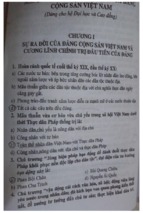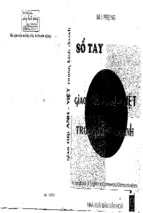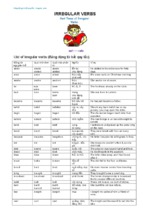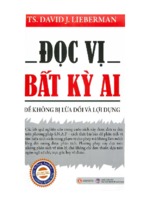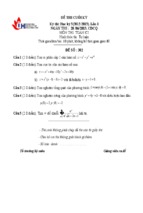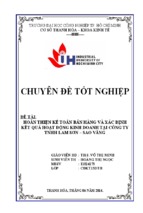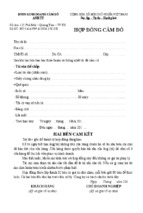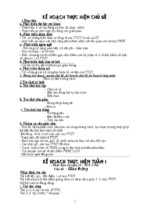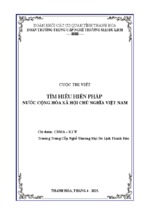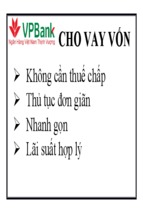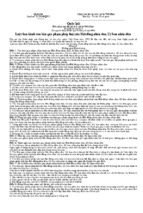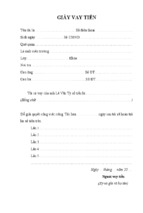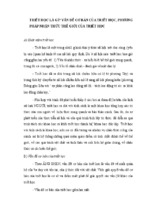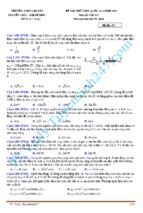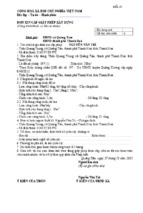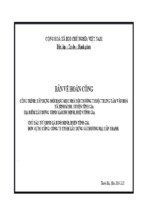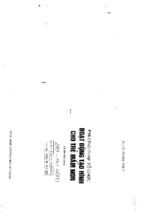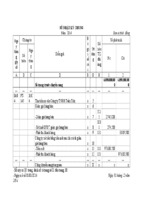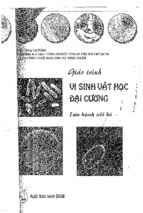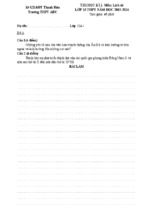MINISTRY OF EDUCATION AND TRAINING
HANOI OPEN UNIVERSITY
M.A Thesis
A CONTRASTIVE ANALYSIS OF SEXIST
LANGUAGE IN ENGLISH AND VIETNAMESE
LITERARY WORKS
(Đối chiếu ngôn ngữ kỳ thị giới trong một số tác phẩm
văn học của Anh và Việt Nam)
Phạm Nguyễn Bình Nguyên
Field: English Language
Code: 8.22.02.01
Hanoi - 2021
MINISTRY OF EDUCATION AND TRAINING
HANOI OPEN UNIVERSITY
M.A Thesis
A CONTRASTIVE ANALYSIS OF SEXIST
LANGUAGE IN ENGLISH AND VIETNAMESE
LITERARY WORKS
(Đối chiếu ngôn ngữ kỳ thị giới trong một số tác phẩm
văn học của Anh và Việt Nam)
Phạm Nguyễn Bình Nguyên
Field: English Language
Code: 8.22.02.01
Supervisor: Dr. Le Thi Minh Thao
Hanoi - 2021
DECLARATION
I, the undersigned, hereby certify my authority of the study project report
entitled "A contrastive analysis of sexist language in English and Vietnamese
literary works" submitted in partial fulfillment of the requirements for the
degree of Master in English Language. Except where the reference is
indicated,
no
other
person‘s
work
has
been used
without due
acknowledgement in the text of the thesis.
Hanoi, 2021
Pham Nguyen Binh Nguyen
Approved by
SUPERVISOR
Lê Thị Minh Thảo
Date:……………………
i
ACKNOWLEDGEMENTS
I would like to express my appreciation to my supervisor, Dr. Le Thi
Minh Thao, who has supported and helped me with her suggestions and
insightful comments all these months in this difficult undertaking of writing a
Master Thesis.
I am indebted to teachers at the Library Department who facilitated me
in browsing and borrowing documents to complete this thesis.
Last but not least, I must thank my family, my seniors and lecturers in
the faculty for the support they provided me during this period.
ii
ABSTRACT
This study focuses on a cross - cultural analysis of sexist language used in
English and Vietnamese literary works. This paper aims to investigate linguistic
factors indicating sexism in various English and Vietnamese literary works,
contribute in studying and elucidating the role of language in gender equality assist
researchers in sexism specifically in terms of English and Vietnamese literary
works. The study used contrastive analysis method to discover the characteristics of
sexism in English and Vietnamese literary works through 12 English literary works
and 09 Vietnamese works. Results of the study showed that sexism in English and
Vietnamese literature are remarkably simple, although sexism against men in
English literature was not apparent. On the other hand, sexism language used
against women was more severe and serious, and the tropes and characteristics of
sexism against women in the two countries are also visibly different. Through
identifying the similarities and differences of sexism in English and Vietnamese
literary works, the study suggests certain methods to avoid sexist characteristics in
literature in particular and in daily life in general so that it could be avoided.
Keywords: sexism, sexist language, English literature, Vietnamese literature,
English literary works, Vietnamese literary works
iii
TABLE OF CONTENTS
ACKNOWLEDGEMENTS .................................................................................................... ii
ABSTRACT........................................................................................................................... iii
CHAPTER 1 ............................................................................................................................ 1
1.1 Rationale: ...................................................................................................................... 1
1.2 Aims and objectives:...................................................................................................... 1
1.3 Scope of the study:........................................................................................................ 2
1.4 Research questions: ....................................................................................................... 2
1.5
Research orientation: ................................................................................................ 3
1.6
Research methods:.................................................................................................... 3
1.7 Structure of the Thesis: ................................................................................................. 4
CHAPTER 2 LITERATURE REVIEW.................................................................................. 5
2.1 Review of previous studies :............................................................................................ 5
2.1.1 Studies of sexism in the world ................................................................................... 5
2.1.2 Studies of sexism in Vietnam .................................................................................... 8
2.2 Review of theoretical background: ................................................................................ 9
2.2.1. Sexism .................................................................................................................... 9
2.2.2. Gender, gender marking and gender system in languages ...................................... 10
2.2.3. The arbitrariness of grammatical gender system, especially gender-identifying
systems........................................................................................................................... 11
2.2.4. Lexical void ........................................................................................................... 12
2.2.5. Morphological imbalance in agent nouns depicting males and females ................... 14
2.3 Summary ...................................................................................................................... 15
CHAPTER 3: SEXIST LANGUAGE IN ENGLISH AND VIETNAMES LITERARY WORKS ...................... 16
3.1
3.1.1
Sexist characteristics in English literary works .......................................................... 16
Sexism against women..................................................................................... 16
iv
3.1.2
Sexism against men ......................................................................................... 27
3.2 Sexist characteristics in Vietnamese literary works ........................................................ 30
3.2.1 Sexism against women ........................................................................................... 30
3.2.2 Sexism against men................................................................................................ 42
3.2.3 Contrastive analysis of sexist characteristics in English and Vietnamese literature ... 44
3.2.5 Summary................................................................................................................ 48
CHAPTER 4 CONCLUSION........................................................................................................ 49
4.1 Recapitulation .............................................................................................................. 49
4.2 Concluding remarks ...................................................................................................... 49
4.3 Limitation of the research ............................................................................................. 50
4.4 Suggestion for further studies ....................................................................................... 51
REFERENCES:.......................................................................................................................... 52
LITERARY MATERIALS ............................................................................................................. 54
APPENDICES: DATA COLLECTION SHEETS ................................................................................ 55
Appendix 1. Sexism against women in English literary works ............................................... 55
Appendix 2. Sexism against men in English literary works.................................................... 61
Appendix 3. Sexism against women in Vietnamese literary works ....................................... 63
Appendix 4. Sexism against men in Vietnamese literary works ............................................ 67
Appendix 5. Proposals for avoiding sexism in English literature ...................................... 71
v
CHAPTER 1
INTRODUCTION
1.1 Rationale:
Gender equality is an important goal not only to Vietnam but also other
nations around the world, also being one of the criteria for assessing the
development of a society. According to the United Nations, gender equality me ans
that women and men enjoy the same conditions to fully realize human rights, have
the opportunity to enjoy and contribute to the achievements of developing countries
in terms of politics, economy, society and culture. However, in reality, gender
inequality still takes place under a number of different forms, such as linguistic
sexism.
Sexism in life is various in forms and different at levels. It is probably most
readily associated with economic issues, such as equal pay for equal work. The role
played by language in maintaining and strengthening sexist values, however, is less
widely understood or acknowledged. This is probably because linguistic sexism is
much more deeply rooted and far more subtle than other forms of sexism. The fight
for equality of both women and men in such domains as politics and economy has
worked effectively and successfully, but in language it seems to be much weaker
and receive far less attention. All normal people must work and most of them know
and require fairness for women and men in labour; all normal people must use
language but few of them are aware of fairness for men and women in language.
And literary works, while being a source of education and inspiration for the
people, are also not exempted from this shortcoming. In old societies, sexism was
expressed not only in daily conversations but also through literary works in those
periods. Thus, this study is conducted in order to investigate the use of sexist
language in English and Vietnamese literature, as well as contribute to reducing
sexism in language and literary works.
1.2 Aims and objectives:
a. Aim of the study: This study aims to investigate linguistic factors
indicating sexism in various English and Vietnamese literary works, contribute in
studying and elucidating the role of language in gender equality, and based on the
results, provide Vietnamese learners of English language and Vietnamese writer
1
with suggestions to reduce and optimally, minimize the existence of sexism in their
language and mindset.
b. Objective of the study: To achieve the aforementioned aim, the study
sought to achieve the following objectives
-
To find out the characteristics of sexism in some English and Vietnamese
literary works.
-
To compare and contrast sexism on certain fields in English and Vietnamese
languages
-
To draw implications of the thesis for English learners and writers in
Vietnamese of writing without showing sexism.
1.3 Scope of the study:
In this study, the author would give spotlight on investigating gender-biased
language on English and Vietnamese literary works ranged from medieval to
contemporary. Gender-biased language in literature can be examined through
specific instances chosen from the literary materials. The materials selected for the
study are classicals covering all historical periods in both English and Vietnamese
literature. For Medieval periods, the study chose Shakespeare Complete Works,
Iliad, The Canterbury Tales, Sir Gawain and the Green Knight, Truyện Kiều, Văn
xuôi tự sự Việt Nam trung đại, Tục ngữ ca dao dân ca Việt Nam, Cung oán ngâm
khúc. For modern periods, Ernest Hemingway‘s collections, Huckleberry Finn, The
winds in the willow, The giver, Nam Cao truyện ngắn tuyển chọn, Tuyển tập Vũ
Trọng Phụng, Tuyển tập truyện ngắn Nguyễn Minh Châu were selected.
1.4 Research questions:
In order to achieve the objectives, the following research questions are raised
for exploration:
1. What are the characteristics of sexism in English and Vietnamese literary
works?
2. What are the similarities and differences between cultural factors of sexism
in English and Vietnamese literary works?
3. How to clarify the hidden message(s) conveyed via the sexism at word and
phrase levels in these books?
2
1.5 Research orientation:
Research approaches: The main aim of the study is to identify sexism
characteristics in English and Vietnamese literary works and provide Vietnamese
writers and learners of English with suggestions to avoid the use of sexist language
in their works. Therefore, to achieve the stated aims, the study utilize s quantitative
and qualitative methods to analyze and compare the main features. The descriptive
and comparative analysis methods are also used to compile the sexism
characteristics in details and clarify the similarity and differences from a contrastive
analysis perspective.
Data sources from citation in literary works as digital sources which contain
sexism expressions. There are 10 English works and 09 Vietnamese works analyzed
in the study, all in PDF formats. These are the primary source of data, while the
secondary source are other books, theses and journal collected from the internet
providing information about sexism.
Data analysis techniques: the study researches and selects facts and examples
from books, M.A thesis before carefully analyzing and identifying the similarities
and differences between sexism expression in Vietnamese and English literature.
1.6 Research methods:
Describing and analyzing the characteristics of linguistic sexism in English
and Vietnamese literature, exploring the similarities and differences between
English and Vietnamese. In order to accomplish the aforementioned achievement,
some methods are used as follow:
The main methods emplyed in this study are descriptive and comparative
analysis methods with quantitative and qualitative approach. The qualitative
method is used to describe and interpret the main features of sexism in
English and Vietnamese from a cross - cultural perspective, while the
quantitative method is used to describe characteristics of sexist language in
English and Vietnamese literature. Comparative analysis and descriptive
methods are used to analyze the gathered information and identify the
similarities and differences of sexism in English and Vietnamese literary.
For achieving the aims and objectives of the study with optimal result,
selected materials is the main technique to be used. In addition, some
3
examples from M.A thesis and journals from the Internet were selected to
help the author find out the similarities and differences of sexist language in
Vietnamese and English literary works.
1.7 Structure of the Thesis:
The thesis will consist of 4 chapters as follow:
Chapter 1: Introduction will be the first chapter of the study. In this chapter,
readers will be provided an overview about what is the purpose of this study, what
to expect from reading it and what value can it brings to their personal experience.
Additionally, the Methodology providing strategies of collecting data, materials and
examples will also be included.
Chapter 2: Literature review and Theoretical background will briefly mention
and review the related materials associating with the objective of the study
Chapter 3: Sexist language in English and Vietnamese will further explain the
materials mentioned along with some critical analysis on what are the main
differences and similarity of sexism in the literature of both languages. Furthermore,
the study will also offer implications for Vietnamese writers in avoiding using
sexist languages.
Chapter 4: Conclusion will provide a summary to the whole study and what
are the limitations when conducting it. Some suggestion might appear for future
references and improvement.
4
CHAPTER 2
LITERATURE REVIEW
2.1 Review of previous studies:
2.1.1 Studies of sexism in the world
Language is not merely a means of exchanging information but it is also
animportant means of establishing and maintaining social relationship with
othermembers of the speech community. Sex-based linguistic variation is an
example of the sort of social function that is fulfilled by language. In fact, sex
differences are a fundamental fact of sociolinguistic life. For example, there are
certain forms of language which are thought to be appropriate only for men to use
and other forms which only women can use. In some cases, these differences
depend not only on the sex of the addresser, but also on the sex of the addressee.
According to Fasold (1990), sex-linked linguistic variation involves ‗the differential
use of certain status marking forms by sex‘ (p. 115). One of the major issues in
sociolinguistic studies has been the relationship between sex and language and how
it is represented. In fact, the study of language and gender began in 1975 by the
publication of three books which have continued to significantly influence
sociolinguistic works: Male/Female Language (M. R. Key), Language and
Women‘s Place (R. Lakoff), and Difference and Dominance (Thorne & Henley).
Since then, sociolinguists have fundamentally shown a great deal of interest in sex
and language relationship mostly with respect to the presence or absence in a few
languages of linguistic forms that are used only by speakers of one sex or the other.
Sexism in textbooks has been studied in Europe and America since 1970s. The most
relevant studies of sexism and its manifestations in ESL/EFL textbooks that can be
tracked down are Hartman and Judd‘s (1978) Sexism and TESOL Materials,
Hellinger‘s (1980) For Men Must Work, Women Must Weep: Sexism in English
Language Textbooks Used in German Schools, and Porreca‘s (1984) Sexism in
Current ESL Textbooks. Hartman and Judd‘s review in 1978 of several then-current
TESOL textbooks examined three categories of sexism: the images of women and
men, firstness (the order of female-male mention), and stereotyped roles for males
and females. They demonstrated that ‗since sexist usage is built into our language
5
(English), it is little wonder that textbooks, including ESL texts, model this usage to
the students‘ (p.390).
For each category, they found evidence that ELT materials reflect sexist
attitudes and values. And they believed this ‗reinforces the second-place status of
women and could, with only a little effort, be avoided‘ (p. 390). Hellinger (1980), a
native German, carried out a study of 131 passages from three ELT textbooks used
in German schools. She found that men were present in more than 93% of the
passages, while only about 30% of the texts included women.
What is more, she proved that 80% of the speakers were male and that women
were rarely participated in demanding, interesting, or successful activities, while
males played their roles in a wide range of jobs. Porreca (1984) investigated how
sexism is manifested in 15 ESL textbooks and with what consequences by using
content analysis method. The author paid attention to omission (the ratio of females
to males) both in texts and illustrations, firstness, occupations, the frequency of
male nouns to female nouns, female-exclusive masculine generic constructions, and
adjectives for men and women. In a content analysis of the textbooks, she found
that ‗there is evidence that sexism continues to flourish in ESL textbooks‘ (p. 718).
She reported that although females comprise slightly over half the population of the
United States, they are represented only half as often as males in both texts and
illustrations. Beside the above important studies of sexism in textbooks, there are
some other studies on sexism in teaching and learning materials that should be
mentioned.
Coles (1977) examined five sets of popular adult basic education materials and
found that in the total of 150 stories, men outnumbered women by a ratio of 3:1.
Britton and Lumpkin (1977) compared reading, literature, and social studies
textbooks published before and after the year 1970 to determine whether guidelines
to correct sexism had resulted in any positive consequences. The changes, however,
were not what to expect: they found that females portrayed as major characters had
increased only by 2%, up to 16% in the new textbooks.
Hoomes (1978) investigated 28 high school literature anthologies for grades 9
through 12 and found evidence that the overall ratio of total female characters to
total male characters in the books was 1:3.5. She also found that the mean ratio of
6
available professions for females to those for males was 1:5 in texts and 1:7 in
illustrations.
In the 1990s, Peterson & Kroner (1992) conducted an examination of gender
biases in textbooks for psychology and human development. Their findings
demonstrated that representation of work, theory, and behavior of males
significantly exceeded those of females; and females were frequently portrayed in
negative and gender biased ways. Poulou (1997) explored differences in the
discourse roles of men and women in dialogs of textbooks for teaching Greek as a
foreign language to adults. Her focus on whether sexist differences could affect
negatively the pedagogical value and goals of textbook dialogs and she
demonstrated that the effect was quite obvious.
Most recently in the early 21 st century, Sydney (2004) investigated gender role
stereotyping in 40 textbooks in primary schools in Tanzania and found that female
characters depicted were fewer compared to males. Bahiyah et al. (2008) found that
children understanding about the world and the relationship within the society were
acquired through Malaysian textbooks, which allowed linguistic sexism and gender
roles stereotyping to permeate into the mind of the students and later reproduce in
their everyday life.
The study by Otlowski (2003) discussed the importance of Japanese textbook
selection for EFL students with regards to the portrayal of gender representation in
the targeted culture. In many cases, the representation of women in EFL textbooks
in Japan portrayed a stereotypical role of women as mothers and homemakers.
Another Japanese linguist, Mineshima (2008), studied gender representations in an
EFL textbook to investigate how it portrays the two genders. She examined sexism
in three categories including number of females versus males, number of their
utterances and firstness. The results of the research showed that females were
under-represented and overloaded with traditional stereotype roles whereas males
appeared only as cooperative and optional. From the above mentioned studies, it is
easy to realize the attraction of sexism in language to the world researchers during
nearly half a century from Europe through America to Asia. In many teaching and
learning materials examined, it was found that females are less visible than males
and that there is sex bias against women.
7
2.1.2 Studies of sexism in Vietnam
In Vietnam, some researchers have been interested in the relation between
language and gender since 1990s. Binh (2000) studied some gender differences in
children‘s language while Dung (2002) demonstrated females‘ politeness in
communication.
Khang (2000) argues that sex discrimination in language may be found in such
categories as words with male factor showing male dominance in society, the use of
he/his instead of she/her, the use of titles like Mr, Mrs and Miss, and stereotype
attitudes in phrases like unwed mother and unwed father.
The first Vietnamese linguist who has systematically studied sexism in language
is Diep (2002). In his works entitled Sự kỳ thị giới tính trong ngôn ngữ qua cứ liệu
tiếng Anh và tiếng Việt (Sexism in language through English and Vietnamese
database), he argues that sexism in language can be found not only against females
but also against males (2002, p. 9). However, sex bias against women is paid more
attention to in his study and it is seen in the following categories.
i) Gender in grammar and its relation with sex in biology : there are
certaindifferent points of view on the relation between gender in grammar and sex
in terms of biology. Some agrees that there must be some relation between them but
some others do not. But the thing should be concerned about is the display of
sexism in the use of gender in language. The male pronouns like he, his and him are
used to include both the two sexes in some cases.
ii) Markedness of sex in language: Many words showing the jobs of
femalesare derived from the words showing the jobs of males. For instance, actress
and waitress are formed by adding the suffix ess to actor and waiter.
iii) Unbalance of words related to females and males in terms of meanings :
Words can have different meanings when they are used to describe men or women.
For example, the word professional has different meaning depending on sex: he is a
professional means he is excellent in a particular aspect while she is a professional
means she is a prostitute.
iv) Sexism in naming/ titles: names and titles are used to show sex and marital
status. In the past, a married woman is entitled Mrs. while Miss is used for an
unmarried one. However, thanks to the fight for equality in using titles, Mrs. and
Miss are now replaced by Ms.
8
v) Stereotypes of sex in language: Stereotypes in describing females in English
can be found in such words/ phrases as a gorgeous blonde, wives of, devoted to a
husband, looking after husband and children. The review of the previous studies
related to the issue shows that there are not many researchers in Vietnam
concerning sexism in language although it has been a heated topic in the world
sociolinguistic research for some decades now. The first study of the topic carried
out by Diep (2002) provides a general view on sexism in language but there is a
shortage of deep investigation into the phenomenon in a specific type of materials.
This has partly urged me to perform the present research.
Based on the findings of forerunner studies, it can be seen that scholars over
the world paid exceptional attention on the issue of sexism in language.
Nonetheless, these studies only cover sexism in the most extensive extent. Thus, the
study will contribute in the work by addressing sexist language in literary works.
2.2 Review of theoretical background:
2.2.1. Sexism:
There are multiple definitions of sexism. Collins Cobuild English Dictionary
(1995) defined sexism as the belief that the members of one sex, usually women are
less intelligent or less capable than those, of the other sex and need not be treated
equally. Sex discrimination or sexism, a term that appears during the mid-twentieth
century, is a belief or attitude that one gender is inferior, less powerful and less
valuable than the other. This term is used to refer to male dominance over female.
The fight against sexism, whose center is the feminist movement taking place in
various forms and not just for women.
In English, the concept of sexism in language has another name: ―Sexist
language‖, ―Sex – exclusive‖ language, ―Gender - biased language‖. Example:
Every cook praises his own broth (Each the chef all praises his own dish), "his" is
used to include "her". The use of the word "his" in such an inclusive fashion shows
that male bias, considering men as a representative of women as well.
Miller & Swift (1972) give the definition: sexism in language or sexist
language is any expression that expresses attitudes and gender expectations or any
expression that expresses the inherent dominance of this world versus the other.
9
The above definitions all show one thing in common. Key points of sexism in
language is in the depiction of images of men and women in language. These
expressions depict higher appreciation for one sex and lower appreciation for the
other.
Wardhaugh (1986) explains that sexism is any discrimination against women
or men because of their sex, and made on irrelevant grounds. The Oxford English
Dictionary (1989) defines sexism as the assumption that one sex is superior to the
other and the resultant discrimination practiced against members of the supposed
inferior sex, esp. by men against women; also conformity with the traditional
stereotyping of social roles on the bases of sex. From these definitions, it can be
inferred that sexism is simply the overestimation of one sex and/ or the
underestimation of the other sex. In other words, it is generally considered as
anything that conveys that one sex is superior to the other.
Understanding the essence of sexism will help the author as well as readers
grasp the characteristics of sexist language in general as well as in the field of
literature.
2.2.2. Gender, gender marking and gender system in languages :
Gender is a grammatical category that affects nouns, it is considered a kind
of system used for classifying nouns into different groups. Those groups or classes
of nouns will behave differently in response to other parts of speech or language.
Although gender is not completely universal in languages, there are still a
significant number of languages displaying the existence of this category. Corbett
(1991: 1) mentioned different sides of gender attribution and gender marking in
more than 200 different languages. However, he also remarked that languages of
almost every language family possess gender systems with a few major exceptions
being certain major Asian language families.
The term "gender" is widely used to refer to this grammatical category, but
there are other terms such as "class" or "class of nouns". The term "gender" is
inherently a word translated from many foreign languages that within those foreign
languages, this term is also translated or borrowed from the Latin word "genus".
Therefore, this is not a word used in everyday language or in specialized texts.
There are many languages possessing a system of 2 or 3 genders, and there are
10
languages with a system of up to 20 genders and subgenders. At the same time, the
labels used for these genders are also very different. Besides the popular labels used
in many languages such as: masculine, feminine, and neutrals, there are other labels
such as: Animal, nonanimal, strong, weak, human, nonhuman, etc. In some cases,
genders are numbered rather than labeled (as in Dyirbal, an Aboriginal language of
Australia).
Corbett (1991: 1) distinguishes two types of gender systems which are grammatical
gender system and notional gender system.
The grammatical system can be subdivided into the morphological system
and phonological system.
The notional system is based on in the semantic-based gender attribution
system of nouns system. Such systems are also called natural systems.
2.2.3. The arbitrariness of grammatical gender system, especially g enderidentifying systems:
Many researchers believe that masculine is used as the "dominant" gender or
the more "valuable" gender than feminine. Based on semantics and morphology,
languages distinguish genders into masculine, feminine, and neuter. In the such
languages, in most cases masculine is the gender determining the response model in
the case of inclusive nouns, depicting both genders with agent nouns for male and
female.
In this aspect, English and Vietnamese are similar in that they both belong to
a type of language that possess a natural gender system or a notional gender system.
In this case, sexism is expressed in the use of masculine pronouns to replace
common nouns of gender in inclusive contexts.
In English, there are speech patterns as follows:
The teacher is responsible for his students.
The word ―teacher‖ is an inclusive word for both genders (can refer to either male
or female), but its corresponding possessive pronoun is "his" (masculine) rather
than "her" (female). Or:
If a friend wishes to become a member, please ask him to write for information.
The word "friend" is also an inclusive word for both genders, but it‘s personal
pronoun is "him" (masculine) rather than "her" (female). Even in similar cases of
11
marked nouns such as ―actor‖, "actress", masculine nouns are often used as
inclusive nouns.
In Vietnamese, in the education sector, a similar example is the use of the
word "thầy" as a title of honor and as a personal pronoun. Nowadays, when
referring to those who participate in pedagogy, people use the phrase ―thầy cô
giáo‖. But in the general relationship between teachers and learners, people often
only use the term ―thầy-trò", but not ―cô-trò". Thus the word ―thầy‖ was also used
to refer to females in this case. In other words, the word ―teacher‖, which was
originally a masculine word, is now used as an inclusive nouns referring to both
gender.
While translating documents and learning materials from foreign languages
to Vietnamese, it is also difficult to avoid using the second personal pronouns "anh"
- a pronoun that includes both men and women. Nguyen Lai (1997: 62) wrote: ―Và
khi xuất hiện thì ngôn ngữ ấy là của tôi và của anh, ngôn ngữ ấy cho tôi và cả cho
anh …‖
2.2.4. Lexical void
In English, many authors believe that, except for certain words depicting
females such as: mother, waitress, etc.. and words that refer to occupations that are
traditionally believed to be done only by women: nurse, secretary, etc., the actual
use of language gives people the impression that humanity is all male (Miller and
Swift, 1972). For example, when one hears the word doctor, that person
immediatelly feels that it is a masculine rather than feminine word. These two
authors argue that the phenomenon exist dueto English as well as the culture it
reflects have a tendency to favour males. In terms of word structure, although in
English, there is a female morpheme – woman, but there is no word fisherwoman
but only fisherman, in that - man is the male morpheme.
In Vietnamese, in essence, the phenomenon of lexical void is similar to that
of other languages, but the form of expression is somewhat different. For example,
when hearing words such as: bác sĩ, kỹ sư, etc., most Vietnamese people
immediately feel that they are more masculine than feminine.
12
Many linguists have tried to trace the origin of these that lexical void and
there have been different interpretations. But we can generalize these interpretations
into two main groups: Linguistic and sociological explanations.
Linguistically, lexical voids affecting the creation of feminine forms of
words is due to what many authors refer to as phonological institution. In other
words, in some languages, the "female" suffix in some words have performed a
function other than the female marking function.
There is another sociological explanation. According to this, the cause of the lexical
voids in words indicating women in certain occupations is the impact of social
factors. It is easy to notice that the absence of female words mainly occurring in the
noun area depicting professions with high social prestige. In English, doctor, lawyer
etc. are professional nouns with high social prestige that according to traditions,
women have difficulties in catching up with. There is a similar phenomenon in
Vietnamese, with nouns referring to people with high-reputation professions such
as: bác sĩ, tiến sĩ, công an, ... or nouns referring to people possessing characteristics
that the society considers typical of men (strong, seasoned, cheeky) such as: đồ vật,
cầu thủ, trộm cướp, etc. Another example in Vietnamese is a way to use the word
thầy in the way of depicting the teacher-student relationship or thầy-trò to refer to
the relationship between teachers and learners. The fact that there is no way to say
the relationship between female teachers and students is the trace of an ancient
concept: Teaching is considered to be the profession of man.
Lexical voids are found in the area of nouns depicting people who do certain
occupations that, although open to men, are not attractive to the majority of men.
This phenomenon is common in many European languages. For example, in Italian,
Dutch, and French there is no word for male midwives and neither is there in
English. In Vietnamese it is the opposite, when we say "nhân viên đỡ đẻ" or "đỡ
đẻ", the listener still understand that these are feminine nouns. Just like in English,
there is no noun illustrating men who work as midwives in Vietnamese. The same
argument can be made for words like hộ lí (health specialization), thư ký giám đốc
(administrative area) etc. These are the manifestations of lexical voids, which have
contributed to the increase in the invisibility of women in language - a feature of
gender discrimination against women in language.
13
- Xem thêm -


